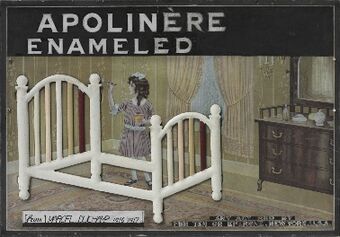Unsolved:Apolinère Enameled
Apolinère Enameled was painted in 1916–17 by Marcel Duchamp, as a heavily altered version of an advertisement for paint ("Sapolin Enamel").[1] The picture depicts a girl painting a bed-frame with white enamelled paint. The depiction of the frame deliberately includes conflicting perspective lines, to produce an impossible object. To emphasise the deliberate impossibility of the shape, a piece of the frame is missing. The piece is sometimes referred to as Duchamp's "impossible bed" painting.
Apolinère is a play-on-words referencing the poet, writer and art critic Guillaume Apollinaire, a close associate of Duchamp during the Cubist adventure.[1] Apollinaire wrote about Duchamp (and others) in his book The Cubist Painters, Aesthetic Meditations of 1913.[2]
See also
- Readymades of Marcel Duchamp
References
- ↑ 1.0 1.1 Philadelphia Museum of Art. "Apolinère Enameled". http://www.philamuseum.org/collections/permanent/51563.html. Retrieved 16 April 2014.
- ↑ Herschel Browning Chipp, Peter Selz, Theories of Modern Art: A Source Book by Artists and Critics, University of California Press, 1968, pp. 221–248, ISBN:0-520-01450-2
External links
 |


